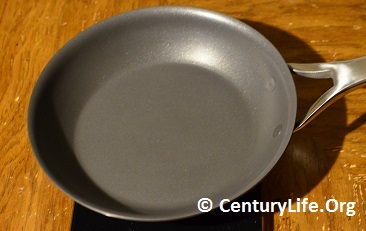Cooking surface: 5/5 Excellent (slippery nonstick, browning can be a challenge especially if dark surfaces make it hard to see what you’re doing)
Conductive layer: 1/5 Very Poor (note that PTFE coatings are very thin so it will not impede the performance you receive from the underlying conductive material, which is usually aluminum)
External surface: 1/5 Poor (fragile and can offgas starting at 400F, at levels of concern to humans at 450-500F+; must keep away from fire from natural gas stoves)
Example: Dupont Teflon, Whitford Xylan
Health safety: 2/5 Poor (can offgas starting at 400F, at levels of concern to humans at 450-500F+)
—–
DEFINITIONS

PTFE stands for polytetrafluoroethylene. DuPont owns the trademark for Teflon, which is a specific type of PTFE. PTFE is an artificial chemical that you can think of as extremely slippery plastic. To prevent PTFEs from flaking off or abrading easily, cookware manufacturers often construct an aluminum pan like so:
- start with a base layer of aluminum and form it into the shape of a pan
- roughen the cooking surface (e.g., spray molten metal and/or ceramic onto it, or etch ridges on the cooking surface), which helps PTFEs adhere to the cooking surface
- apply PFOAs and PTFEs on the cooking surface
- bake the pan, which cooks off almost all of the PFOAs and leaves just the super-slick PTFE surface. (PTFE is so slippery that it does not like to bond to metal, hence the use of PFOA.) [Read more…]